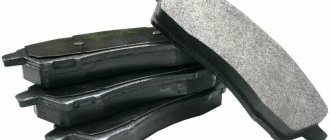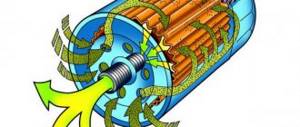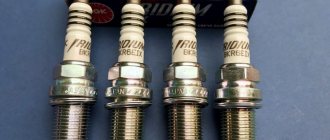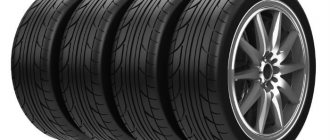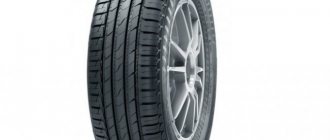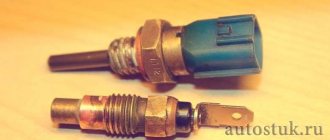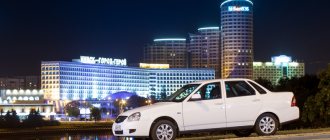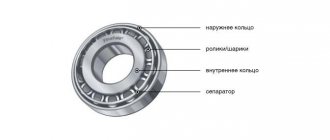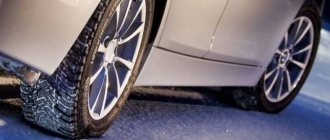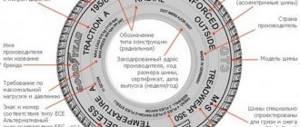Let's review the Autoreview test
From the very beginning of testing, experts identified the leader - Michelin.
How could it be otherwise - with such and such a number of studs: on a Michelin tire of size 215/60 R17, we counted 269 of them! For comparison: the new Pirelli Scorpion Ice Zero 2 tires have 192 studs, while the Nokian Hakkapeliitta 9 SUV has only 136. Why is there so little, since three years ago the same smaller Nokian tires had 172 studs? We go to the test site owners for clarification, and it turns out that there is no mistake: in the model line of Nokian Hakkapeliitta 9/9SUV tires there are indeed several standard sizes (including the test 215/60 R17), in which the number of studs had to be reduced in order to pass the so-called overrun test for asphalt wear. Since 2013, all winter tires with more than 50 studs per linear meter of tread must pass it in Europe. In Russia the norm is higher - 60 thorns. That is, “our” tires of size 215/60 R17, according to Russian standards, must pass the test if they have more than 130 studs, and according to European standards - more than 108. This means that half of the test models were allowed onto the Russian market through an overrun test. But how did such “toothy” Michelin tires manage to pass this test? It's simple: there are a lot of spikes, but they are noticeably smaller than those of competitors. Moreover, the “studded arms race” has many opponents: in the countries of Northern Europe, new standards have already been prepared that will force tire manufacturers to reduce the number of studs or make them smaller, as in Michelin tires. Clouds have also gathered over studded tires in Russia. Autoreview has not yet completed the tests, but the Duma Committee on Transport and Construction has already discussed measures to reduce the harm that studded tires cause to Russian roads. Proposals include returning the “Spikes” sign, limiting speed, or even banning the use of studded tires altogether. Gentlemen legislators! Before you hack away, check out our test results. Compare the minimum braking distance of a car on studded Michelin tires and the best friction tires - the difference is one and a half times! At a snail's speed of 25 km/h this is about five meters, and at a speed of 100 km/h it will already be tens of meters!
However, reasonable restrictions are needed. After all, ruts in the left lanes are the consequences of driving on studded tires. For example, on highways in winter it is quite possible to limit the speed of cars wearing spikes. Then drivers will decide for themselves what is more important to them - safety on a slippery road or the opportunity to speed along clean asphalt with the breeze.
Well, our ice and snow tests were won by Michelin X-Ice North 4 tires. Of the more affordable tires of the so-called second line, we recommend paying attention to Formula Ice tires: they hold up well on slippery roads, especially in corners. But the Gislaved and Toyo studs were disappointing: in some tests their grip on ice was worse than that of the friction ones.
What about our “used” tires? When braking on ice, there is virtually no degradation, because on worn tires the studs rise above the tread level by 1.3 mm versus 1.1 mm on new ones, thereby compensating for the wear of the rubber edges. However, this is not enough in corners - with worn Nordman 7 SUV tires, the lap time (950 meters) increases by 8.5 seconds!
On snow, the spikes no longer work, and the rounded edges cling to the snow much worse. And if on virgin soil the difference in results between the best and worst new tires is less than a second (we measured the dynamics of acceleration to 10 km/h with constant slipping and rear wheel drive disabled), then on worn Nordman 7 SUV tires the car flounders in the snow for an extra 2.7 seconds compared to the worst tires from the main classification!
At the end of the winter tests, all test tires were transported to the Nokian summer test site in the city of Nokia. We are waiting for April and... staying at home. We hoped that the borders would open in September, but alas, it did not happen. Fortunately, our Finnish colleagues themselves conducted tests on wet asphalt, in an aquaplaning bath, and measured internal noise on asphalt. True, not on Arkan, but on the co-platform Duster.
Incorrect? Could you play along with your tires? But take a look at the results and you will understand that there is no reason for such suspicions. As in previous tests, this year the Nokian Hakkapeliitta 9 SUV tires were recognized as the noisiest. This is their main drawback - it was the one that did not allow them to rise above third place in the final rankings. In second place is this season’s new Pirelli Scorpion Ice Zero 2. Well, the winner of the test was Michelin X-Ice North 4 tires - which are inferior to competitors only when braking on wet asphalt. But I will not dissuade those who are going to buy these tires for city use: having driven them to St. Petersburg on winter asphalt, I can say that they do not turn the car into jelly.
Why are there no Continental IceContact 3 tires with “rubber” studs in the test this time? Alas, they were discontinued: in Scandinavian countries, buyers began to file complaints due to... studs falling out. It’s strange, of course: having driven these tires to St. Petersburg and then carried out a series of measurements of the braking distance from high speeds, I did not notice a single stud that fell out. But be that as it may, this year IceContact 3 tires in the entire range of sizes began to be equipped with conventional studs - including at the Kaluga plant. And they simply didn’t have time for our test.
But for the third year in a row, the Continental VikingContact 7 friction tires became the best in the studless class. The friction clutches of Goodyear UltraGrip Ice SUV and Nokian Hakkapeliitta R3 SUV are somewhat inferior to them. But the model of the second line Gislaved Soft*Frost 200 from the same company Continental, alas, did not impress.
Is it possible to extend the results of our test to tires of other sizes and without the SUV index (or in the case of Pirelli - with the additional name Scorpion)? I'm sure so. Please note that the SUV index is not supported by any mandatory tests and manufacturers use it more for marketing purposes - by design, these tires are often only reinforced according to the load capacity index.
Winter tire test from Autoreview 205/55 R16.
Experts from the Russian magazine Autoreview compared 10 studded tires of size 205/55 R16.
List of tested tires:
- Bridgestone Ice Cruiser 7000
- Continental ContiIceContact
- Dunlop Ice Touch
- Gislaved Nord Frost 100
- Goodyear UltraGrip Ice Arctic
- Hankook Winter I*Pike W409
- Michelin X-Ice North XIN 2
- Nokian Hakkapeliitta 8
- Pirelli Ice Zero
- Kama Euro 519
ICE
The Audi A3 hatchback was chosen as a test car. The studded tire test began with a braking performance test. Now - a dozen accelerations and decelerations, then - on the lift, changing tires, acceleration and braking again...
Despite the fact that acceleration is controlled by the traction control system, and deceleration is controlled by ABS, the studs crush smooth ice into snow powder.
First sensation! ContiIceContact tires have the shortest braking distance. They also provided the car with better acceleration dynamics. And although the advantage over Hakkapeliitta 8 tires is very small, it is there! That is, 190 studs lined up in 18 rows perform no better on the ice than 130 studs distributed over 12 rows. At least in 14-degree frost. Why? Yes, because to reduce the harmful effects on the road surface, the Finns really had to change the design of the studs: they are not only lighter, but also smaller - in height and diameter - than those used in Continental tires. And those that were previously used in Nokian Hakkapeliitta 7 tires. And the carbide insert of the “small” studs is not so powerful.
The two favorites are hot on the heels of the new Pirelli Winter Ice Zero tires.
Another bright new product this season promises to be the Gislaved Nord Frost 100 tires. There are already 96 “legal” studs - and they provide quite decent braking on ice, although during acceleration they are only the eighth result. The Goodyear UltraGrip Ice Arctic and Dunlop Ice Touch and Michelin X-Ice North 2 tires, familiar to us from last year’s tests, were also ahead. By the way, why is Michelin represented by the second generation X-Ice North tires and not the third? The company decided that it would be better not to give these tires to anyone for comparative tests until the new model is officially launched on the market.
Bridgestone also prepared new products for the winter season, but also refused to provide them before the official premiere. That’s why our category includes Bridgestone Ice Cruiser 7000 tires, which will also be actively sold on our market this coming winter.
The Korean school is represented by Hankook Winter i*Pike tires, and the Russian school is represented by Kama Euro 519 tires. On ice, the results of both are very modest. But for now we are talking only about grip qualities in the longitudinal direction.
The handling assessment began with driving around an ice circle at the highest possible speed, and continued on a winding track, where both lap time and a subjective assessment of the comfort and reliability of control were taken into account. In these exercises, the Nokian Hakkapeliitta 8 tires already achieve a convincing victory.
Continental tires are in second place, and closely behind them are the second, albeit small, but still a sensation - Gislaved tires. On Goodyear UltraGrip Ice Arctic tires, the car brakes and accelerates well, but handles poorly in corners.
SNOW
The next day the frost dropped from fourteen degrees to minus seven. The test of studded tires from Autoreview continued on a 600-meter track with perfectly packed snow. The work will be monotonous: acceleration to 50 km/h, braking, acceleration again, braking again... But if previously the driver was required to work with the pedals in order to prevent unnecessary wheel slipping at the start and blocking during braking, now this is monitored electronically - Traction Control and ABS. And soon, it seems, it will be possible to do without a driver altogether.
Test results on snow showed that when braking, the test participants are very close: the difference between the best Dunlop tires and the worst Bridgestone is less than three meters, which is within ten percent. During acceleration, the spread is slightly larger, about 20 percent, and the favorites here are different - Nokian tires. That is, the Finns conjured up not only the studs, but also the tread, because in the snow it is not so much the studs that are important as the tread itself.
ASPHALT
A series of disciplines on asphalt began with a test of the behavior of different tires on slush - a snow-water porridge that covered the asphalt with an even 35 mm layer. The weakest Hankook tires floated at 19.4 km/h, while the best Bridgestone tires began to lose contact with the road at 21.2 km/h.
And on wet asphalt, no longer mixed with snow, the shortest braking distance belongs to the Gislaved tires, and the worst is the Nokian Hakkapeliitta 8.
Yes, yes, skeptics from other tire companies have already whispered that with so many studs, Nokian tires will not work well on asphalt. On a wet surface this is true, but on a dry surface the Nokian Hakkapeliitta 8 tires showed one of the best braking results. This, by the way, is an occasion to remind again that modern studded tires work on asphalt no worse, and sometimes even better, than non-studded Scandinavian-type tires - those that are popularly called Velcro. This is due to the stiffer rubber, which is necessary for reliable fixation of the studs. There is still a myth in circulation that a studded tire rolls on asphalt, relying more on the studs than on the rubber. But in fact, the spikes, in contact with the asphalt, are recessed into the body of the tread, practically not reducing the contact patch between the rubber and the road. However, it all depends on what goals the manufacturer sets when creating a specific tire model. By changing the tread pattern, hardness and chemical composition of the rubber, you can shift the balance of qualities, giving preference to either behavior on slippery winter surfaces (ice, snow) or on asphalt.
With Dunlop Ice Touch tires, this balance is clearly shifted towards asphalt: the Audi A3 brakes confidently and responds best to sharp turns of the steering wheel. But on ContiIceContact tires, the braking distance on both dry and wet asphalt is a couple of meters longer, that is, preference is given to “winter” qualities.
Where studded tires always lose to non-studded tires is acoustic comfort. There is clearly more noise from them, especially if the tread has as many as 190 studs, like Nokian tires. However, even with fewer studs, Kama Euro, Pirelli, Continental and Bridgestone tires click about the same. And the quietest tires are Michelin X-Ice North 2. Along with the Nokian Hakkapeliitta 8 tires, they are also the softest.
How will such soft tires behave if they fall into a hole or run into an asphalt ledge? This test goes as follows: at a speed of 40 km/h, a car runs into a steel channel installed at an angle of 30 degrees - a piece of U-shaped beam. If the tire holds up, the attempt is repeated at a speed of 45 km/h. And so on until the tire “gives up the ghost.” For this test, experts took an old Mercedes-Benz C 180.
Bridgestone tires withstood the most impacts: they were only punctured at a speed of 70 km/h! And this is no coincidence: when developing their tires, the Japanese take into account the specifics of bad roads, strengthen the structure and test it themselves with crash tests.
The Continental tires also hold up well - they gave up at a speed of 60 km/h. The bulk of the tires were finished off at a speed of 50 km/h, but the Michelin tires, which we liked so much for their softness, were punctured in the very first race, at a speed of 40 km/h. Experts even decided to repeat the experiment - what if it was an accident? Bang! Psh-sh-sh... And the second Michelin X-Ice North 2 tire with a through hole is sent to the landfill. And again, everything is understandable: lately the French have been paying more and more attention to reducing rolling resistance, for which reason the sidewall is becoming thinner.
The test of studded tires from Autoreview also included a rolling resistance test, which was carried out using a running drum. And it turned out that the Nokian Hakkapeliitta 8 tires roll easier than others, and not the Michelin X-Ice North 2. But this is without studs, since studded tires would damage the calibrated surface of the drum. It is not a fact that this rating will not change with spikes. However, since the experiment was carried out without spikes, the experts did not take its results into account when making their final assessments.
Test results
Studded tires
Michelin X-Ice North 4
“Small ones, but bigger ones!” - this is exactly the choice of the number of studs made by Michelin. And they were right: the X-Ice North 4 tires, produced at the Russian plant in Davydovo near Moscow, have excellent grip properties on ice. And on snow, the directional pattern works perfectly. But the main advantage of these tires is the combination of outstanding winter performance and moderate rolling noise. Small spikes “play” at a higher frequency compared to traditional “nails” - instead of a hum, the driver hears a slight rustle. And even modest grip on wet asphalt did not prevent Michelin studs from becoming the best this season.
Pirelli Scorpion Ice Zero 2
The new Pirelli Scorpion Ice Zero 2 tires have already made history as the first studs homologated for the Lamborghini Urus supercrossover. And now they came in second place in our test. Powerful shaped studs provide good grip on ice, although the noise they make is moderate. Aquaplaning resistance is the best of any studded tire we've tested. So Pirelli Scorpion Ice Zero 2 tires are suitable not only for country roads, but also for urban winter use.
Nokian Hakkapeliitta 9 SUV
Even with a reduced number of studs, the Nokian Hakkapeliitta 9 SUV tires demonstrate excellent grip on ice. And on the handling track they are the fastest! There are not many studs, but they are of two types and in the shoulder area they are sharpened for emphasis in turns. In the snow, everything is also not bad, although in loose powder, where the spikes practically do not work, the new models of competitors are preferable.
On asphalt, Nokian tires performed quite well in braking and demonstrated good resistance to aquaplaning. But they are the noisiest among the test samples, and subjective impressions this time confirmed the measurements. And the price tag is even more depressing...
Hankook Winter i*PikeX
Hankook Winter i*PikeX tires with the factory index 429A are formally a new model, but this is just a crossover modification of the already familiar Winter i*Pike RS2 passenger tires. However, the X version has fewer studs (164 versus 198), but deeper grooves (9.7 versus 9.0 mm). The aggressive tread proved to be the best in the virgin snow - these tires are the easiest to get out of snowdrifts! And on the snow handling track - the best time. And on ice, these spikes are only slightly inferior to the test leaders.
However, modest achievements on asphalt allow us to recommend them primarily for regional use - where there are not many clean roads in winter. And the price for tires of this level is humane.
Formula Ice
Russian-made Formula tires are the “second line” of Pirelli. And if three years ago they performed unsuccessfully on the ice due to the too deep studs, then this year there are no complaints about the performance of the studs. And the results are consistent: on the track, Arkana’s handling on Formula Ice tires was even faster than on Pirelli Scorpion Ice Zero 2 tires! On virgin snow, the advantage is also on the side of the Formula. And for residents of megacities, the grip properties on wet asphalt will be very valuable - the best among all studded competitors!
As a result, Formula is cheaper than Nordman or Gislaved, and it has a better range of consumer properties.
Nordman 7 SUV
Nordman 7 SUV tires are the “second line” and are produced in the molds of previous Nokian models. But the materials are simpler (for example, rubber hardness is 55 units versus 50 for the Nokian Hakkapeliitta 9 SUV). Accordingly, the characteristics are more modest - especially on snow, where the tread pattern and material are most important. And our experiment with tires that traveled 10,000 km showed that it is on snow that degradation is most felt: the “nails” on ice continue to work, but the rubber edges of the tread become dull.
But in general, Nordman 7 SUV tires remain an attractive offer in terms of price and quality ratio. But they make a lot of noise.
Gislaved Nord*Frost 200
Gislaved Nord*Frost 200 tires performed noticeably more modestly this year than last year. We can only guess what the reason is—lower quality studs or “optimization” of the rubber compound. But on ice, the studded Gislaved loses even to friction models. And on the handling track, constant slipping of the rear axle did not give the ESP system a rest.
At the same time, on compacted snow, Gislaved tires provide the absolute minimum braking distance! At the same time, the asymmetrical tread performs mediocrely in deep snow.
But what remains the same is that these are still some of the quietest studs on the market.
Toyo Observe Ice-Freezer
Strange: Toyo Observe Ice-Freezer tires have a lot of studs, and their cores are pentagonal, and there are no problems with flyout. But in terms of deceleration on ice, these tires are inferior to most friction clutches on our list. At least it’s good that the Arkana rides obediently on Toyo studs along the handling track. Albeit slowly.
On compacted snow the performance is average, but getting out of the snowdrifts is a bit difficult: when the tires are pressed in, they still paddle, but when they slip, there is not enough traction. Verdict - these are quiet, relatively inexpensive studded tires, which you will have to drive very carefully on in icy conditions.
Final rating
The second ten is printed by the “twins” - Marshal I'Zen KW31
and
Viatti Brina
, which scored
833 points each
. But their characters are different.
Last place goes to Nexen WinGuard Ice Plus
, earning
803
total points. It can only boast of a decent level of comfort. The adhesion properties on any surface are frankly weak. Decent except for directional stability in the snow and behavior during sudden lane changes. The concept of passability is somewhere far to the side. You can drive the Nexen on any road only slowly and carefully. And only with electronic limiters, while understanding that there is little hope for them.
Viatti Brina - similar in characteristics to the Marshal on “white” roads. But in nuances it is contradictory. On the one hand, this is the test leader in braking on snow. On the other hand, it handles worse in the snow during active driving and in extreme maneuvers. On asphalt it looks weaker than the Marshall - it brakes worse in wet and dry conditions, and has poor directional stability. In terms of comfort and efficiency, it is slightly better than the Marshall. It will reveal its best qualities on snowy roads if you do not turn off the electronics.
| 13th place | 12th–11th place | |
| brand, model |
Nexen WinGuard Ice Plus |
Viatti Brina |
| Sum of points scored in the test | 805 | 833 |
| Average price in online stores at the time of preparation of the material | 4030 rub. | 3250 rub. |
| Savings (+)* / overpayment (-)*, % | 28 (-) | 15 (+) |
| Country of manufacture | Korea | Russia |
| Load and speed index | 91T | 91T |
| Pattern depth, mm | 8,1–8,4 | 7,7–8,4 |
| Shore hardness of rubber | 57 | 56 |
| Tire weight, kg | 9,1 | 8,5 |
| PROS | Decent directional stability on snow, steering control and smooth ride | Leading brakes on snow; medium brakes on ice; decent ride smoothness |
| MINUSES | Very weak grip on ice and snow; worse brakes on dry asphalt; worst efficiency | Worst brakes on wet pavement; difficult course on asphalt, behavior on ice and snow |
* The difference between the fair price and the average price of a particular tire model, expressed as a percentage of the average price.
Non-studded tires
Continental Viking Contact 7
For the third year in a row, Continental VikingContact 7 tires became the best tire in the non-studded class. The key to stability is an excellent balance of performance on different surfaces. On Continental VikingContact 7 tires, the car rides very tenaciously on bare ice, and the acceleration time on snow is absolutely record-breaking. Surprisingly, even on virgin soil the Conti loses only to the “toothy” Hankook tires.
And with such excellent winter properties, Continental tires are also good on wet asphalt, and they also resist hydroplaning well and are not noisy.
Goodyear UltraGrip Ice SUV
It’s easy to get lost in Goodyear’s winter tire models: UltraGrip Ice+, UltraGrip 2, UltraGrip Ice SUV, UltraGrip Performance SUV with similar or even identical patterns. However, unlike studded models, which have not been updated for a long time and are therefore noticeably inferior to competitors, Goodyear friction winter models have a good year every year. This time they secured second place in the class. True, traction on ice is not their strong point, although the Arkana rides confidently on the handling track on these tires. But on asphalt there is a short braking distance and the highest speed in a hydroplaning bath. Plus silence when rolling. This means that these tires are best suited for winter use in large cities.
Nokian Hakkapeliitta R3 SUV
Everyone is already accustomed to the fact that Nokian is the best winter tire. And therefore the most expensive. So for Hakkapeliitta R3 SUV tires of a relatively modest 17-inch size you will have to pay almost 40 thousand rubles per set! For this money you will get tires with high traction on ice, but not the best performance on snow. And most importantly - with polar asphalt indicators. On the one hand - minimal braking distance, on the other - worse resistance to aquaplaning and increased noise.
Maybe the Finnish company is too keen on creating tires for electric vehicles with reduced rolling losses? Is it due to a decrease in traditional winter indicators?
Toyo Observe GSi-6
As you know, studs are prohibited in the Land of the Rising Sun - it is not surprising that the Japanese are better at friction tires than studded ones. And if the Toyo Observe Ice-Freezer spikes are in the rearguard, then the Observe GSi-6 model is one step away from the podium in its class. On ice, these tires delight with good traction, and on the track with handling - a soft start to sliding. They work only a little worse on snow.
The performance on asphalt is also good, but these tires don’t like large amounts of water—they float up early in puddles. But on clean asphalt you can easily accelerate to 210 km/h - despite the fact that the rest of the participants in our test are designed for speeds of 170-190 km/h. However, for most buyers the main advantage of Toyo friction tires will be the price - 20 thousand rubles per set. Japanese, we note, made.
Hankook Winter I*zept iZ2
Hankook friction tires are in the middle range. On ice there is an imbalance between the longitudinal and lateral grip properties: during acceleration, the tires provide the best dynamics in the studless class, but on the track the handling forces the Arcana to hang in the slides, which is felt even through the operation of the ESP. And on snow the situation is similar: good results on acceleration and braking and one of the worst times on the handling track.
In asphalt tests, Hankook tires performed average in both aquaplaning resistance and braking properties. And they were remembered primarily for the lowest noise level.
Nokian Nordman RS2 SUV
In general, Nordman RS2 tires maintain subordination: in most tests on ice and snow, they are, albeit slightly, inferior in their performance to the first-line Nokian Hakkapeliitta R3 SUV tires. The biggest lag is on the handling track - three seconds per lap of less than a kilometer! But there are no problems with car control: sliding is soft and predictable. The situation is similar on snow: the difference in longitudinal dynamics is small, but on the handling track there is a two-second lag. On asphalt, Nordman RS2 SUV tires are noisy, but with aquaplaning there are no problems that were recorded with Nokian friction tires. But in the end, the Nordman RS2 SUV is a good option for winter tires with an adequate price tag.
Gislaved Soft*Frost 200
Friction tires Gislaved Soft*Frost 200 performed rather modestly in our test three years ago, and this season they ended up at the bottom of the rating. It didn't even help that they were made in Germany.
It would seem that a tread made of the softest rubber is simply obliged to work well on ice. But the adhesion properties are extremely low in both the longitudinal and transverse directions. And in the snow there is confusion and swaying: during acceleration and braking the results are quite decent, but in corners the tires do not hold up. And it’s difficult to rake through virgin soil.
And on asphalt, tires with a soft tread are completely evil: sluggish reactions to steering turns, a long stopping distance. Plus poor resistance to hydroplaning. So it’s clear why tires from the famous northern brand Gislaved are the cheapest in our test.
Source: autoreview.ru
For both cars and SUVs: Pirelli Ice Zero tire test
Among the advantages of Pirelli Ice Zero, the manufacturer promises good grip on ice both during acceleration and braking, as well as improved grip on snow due to an increase in the number of transverse sipes. And if the first statement is justified by the specific shape of the stud, then the second must be read taking into account the age of the model - after all, enough time has passed since 2013, when these tires debuted. However, the density of lamellas on winter tires is not growing as rapidly as the capacity of video cards or the Bitcoin rate, and a clear proof of the success of the tire is the fact that since 2013 it continues to find its buyers. Let's see what exactly attracts them to her.
First meeting
Large blocks of the tread pattern, a clearly defined shoulder area, a really high density of transverse sipes, as well as the “toothed” edges of the beginning of these sipes with an increased width - this is what immediately catches your eye in addition to the shape of the stud. Meanwhile, the manufacturer focuses its main attention on the spikes - and his statements seem justified. The spike is made in the shape of a “cut arrow”, looking in the direction of the pattern: when accelerating, it rests on the surface with two sharp edges, and slows down with a wide “cut” front part. At the same time, on the lateral shear it is also sharp, but narrow - apparently, the emphasis is on the edges that should effectively bite into the ice. Well, the wide base of the stud, hidden under the “stamp” around it, is designed to ensure wear resistance and stable performance characteristics.
All this sounds and looks, combined with the traditional clarifications about “testing in the harshest winter conditions,” quite well: a deep and large tread should really ensure good self-cleaning on snow and decent cross-country ability - especially since the tire is addressed to both owners of passenger cars and SUV owners. A wide “directional” spike should also perform better than a conventional “ordinary” one. All that remains is to check if this is so.
Road tests
Already the first “break-in” hundreds of kilometers, which took place at near-zero temperatures, made it possible to understand that the rubber is indeed soft, and large tread blocks have a positive effect not only on driving on snow, but also on draining water from the contact patch. The rubber does not “float” at any city speeds and does not sag in snow and mud, and braking on wet asphalt always remains predictable, even despite the studs.
The decrease in temperature and the end of the run-in did not bring disappointment: on clean, cold asphalt, Ice Zero brakes very confidently, without, of course, canceling the need to keep a distance while adjusting for icy “bald spots.”
But the difference in the dynamics of acceleration and braking on an icy road, adjusted for the asymmetry of the stud, was not possible to feel with the “back”: in both cases, it was not the shape, but the width that was decisive. But I was pleased with the behavior of the car on the new tires when cornering: drift was achieved only with a clear overestimation of the capabilities of the car itself at the entrance to the turn. The predictability of slipping remained entirely on the choice of speed: if the car did not “slide” outward at the entrance to the turn, then it remained on the given trajectory until the very end of the maneuver.
However, there were some comments - the main and, perhaps, the only thing was the background noise. Despite the standard stud height and quite “urban” tread pattern, the noise from the tires subjectively seemed a little greater than expected. Perhaps this should be attributed to the “age” of the tires: a lot of water has already flown under the bridge since 2013, and Ice Zero may simply not be the quietest in the line. However, noise on clean asphalt is the inevitable scourge of all studded tires, and in our case there is no question of any outstanding level of this noise: you just have to take into account that it will directly depend on the noise insulation of a particular car. But even the subjectively noticeable noise background did not add equally noticeable vibrations - according to this indicator, the Pirelli test subjects were in perfect order.
Off-road tests
Off-road tests in our case, of course, ended a few “dirt” kilometers from hard asphalt - it would be too naive to count on a full-fledged off-road on “civilian” tires and a low passenger car. But we were able to check the behavior of the tires on both compacted and loose snow - and in both cases it did not cause any concern. Packed snow is given by Ice Zero as uniformly as ice: both acceleration and braking are predictable and confident. On loose snow, fresh tires clearly lay a fresh track until they hit either the maximum angle of ascent or the maximum depth of the snow cover. True, in the first case it simply skids, hinting that the section can be overcome by walking, but in the second it begins to dig in - so it’s not worth skidding “until the last”, hoping for self-cleaning of the tread and a miracle, and not only on this one, but and on any other sensible winter tires.
Well, in urban conditions, the capabilities of the new Pirelli were more than enough: in the absence of heavy snowfalls, the courtyards had not yet turned into “ice battles,” but snow and ice had already taken their positions. Despite this, cross-country ability and, importantly, maneuverability in cramped conditions turned out to be completely sufficient for confidently visiting any local areas. Braking at low speeds can be called exemplary - slippage is minimal.
Price
14 inch tire
from 3,000 rubles
It’s too early to talk about the strength and wear resistance of rubber - for this you need to drive not just a few months, but at least a full season. However, the primary confirmation of the strength of the sidewalls are several “baptisms of fire” at hard joints and in large holes, which left no reason to doubt the quality of the rubber and cord on the tires. By the way, Ice Zero’s assortment also includes tires with run-flat technology - this is especially important given its “versatility” for cars and SUVs and its targeting, including expensive cars.
Financial tests
The focus on expensive cars, however, was not the only one for Pirelli: Ice Zero is available in sizes from 14 to 22 inches. At the same time, in any of the mounting diameters it turns out to be slightly above the middle of the price range, which is fully justified both by the age of the model and by its positioning. The cost of a 14-inch tire starts at about three thousand rubles - this is by no means the lowest figure, but its “payback” after the first acquaintance is beyond doubt. It seems that it is this combination of good performance, average price, wide off-road-passenger positioning and the presence of Run Flat versions that provides the Pirelli Ice Zero with a sufficient consumer audience. Case is closed!
Test results for studded winter tires
According to a series of tests of winter crossover or SUV tires conducted by the Autoreview publishing house in 2020, a rating of the best tires r14, r15, r16 or r17 was compiled.
According to a series of Autoreview tests, the most prestigious winter tires can confidently be called Cordiant products, but the most useless for off-road driving are Viatti tires.
In the rating of winter tires according to Autoreview tests, the places were distributed as follows:
- Nokian Hakkapeliitta 9 SUV is a studded tire with two types of studs, which:
- recommended for driving on city and country roads,
- excellent grip on ice,
- maneuverability and controllability on snow,
- availability for five dozen standard sizes, including from 215/65 r16 to 315/40 r 21,
- excellent level of braking on slippery surfaces,
- however, the tires are incredibly noisy, especially when accelerating to ninety kilometers per hour,
- the cost of tires is quite high.
Nokian Hakkapeliitta 9 SUV
- Hankook Winter i*Pike RS+ studded tires, which can be purchased for sizes 205/55 r 16 and 215/65 r 16:
- excellent traction on ice or snow,
- increased maneuverability and controllability,
- smooth ride quality,
- increased number of star-type spikes,
- they are inexpensive, but do not move well in deep snow,
- have increased noise.
Hankook Winter i*Pike RS+
- Gislaved Nord*Frost 200 is a studded tire that can fit seven dozen cars 155/70 r 13, 205/55 r 17, 265/60 r18 to 275/40 r 20 and showed:
- increased adhesion to asphalt pavement,
- controllability and maneuverability,
- increased cross-country ability,
- the simplicity of the spikes with the absence of thermochemical type fixation,
- showed excellent properties in the transverse direction.
Gislaved Nord*Frost 200

